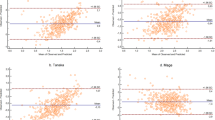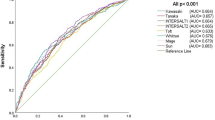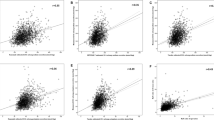Abstract
Although 24-h urine collection is widely considered the ’gold standard’ for estimation of population sodium intake, spot urine collection is increasingly used as a convenient and affordable alternative. We used four published formulae to convert spot urine sodium into estimates of 24-h sodium excretion in order to establish which (if any) formula would be suitable for use in the New Zealand population. A convenience sample of 101 healthy volunteers provided two spot urine samples and a 24-h urine collection. Two formulae (one proposed by the Pan American Health Organisation (PAHO) and one derived from INTERSALT data) were most accurate, and provided estimates of key population indicators (mean, range and proportion above nutrient reference values) that were close to those of the measured 24-h urine excretion. Estimates using these formula were in closer agreement with 24-h excretion than the other formulae estimates using the Bland–Altman method. We conclude that spot urine sampling is a suitable alternative to 24-h urine collection in population surveys when spot urine sodium results are converted into estimates of 24-h sodium excretion using either the PAHO or INTERSALT formulae. However spot urine is a poor predictor of 24-h urinary sodium excretion for individual assessment.
This is a preview of subscription content, access via your institution
Access options
Subscribe to this journal
Receive 12 digital issues and online access to articles
$119.00 per year
only $9.92 per issue
Buy this article
- Purchase on Springer Link
- Instant access to full article PDF
Prices may be subject to local taxes which are calculated during checkout

Similar content being viewed by others
References
Chobanian AV, Bakris GL, Black HR, Cushman WC, Green LA, Izzo JL et al. Seventh report of the Joint National Committee on Prevention, Detection, Evaluation, and Treatment of High Blood Pressure. Hypertension 2003; 42: 1206–1252.
Obarzanek E, Proschan MA, Vollmer WM, Moore TJ, Sacks FM, Appel LJ et al. Individual blood pressure responses to changes in salt intake: results from the dash-sodium trial. Hypertension 2003; 42 (4): 459–467.
He FJ, MacGregor GA . Effect of longer-term modest salt reduction on blood pressure. Cochrane Database Syst Rev 2004 (1): CD004937.
He FJ, MacGregor GA . Importance of salt in determining blood pressure in children: meta-analysis of controlled trials. Hypertension 2006; 48: 861–869.
Cook NR, Cutler JA, Obarzanek E, Buring JE, Rexrode KM, Kumanyika SK et al. Long term effects of dietary sodium reduction on cardiovascular disease outcomes: observational follow-up of the trials of hypertension prevention (TOHP). BMJ 2007; 334: 885–892.
Strazzullo P, D'Elia L, Kandala N, Cappuccio FP . Salt intake, stroke, and cardiovascular disease: meta-analysis of prospective studies. BMJ 2009; 339: b4567.
Bibbins-Domingo K, Chertow GM, Coxson PG, Moran A, Lightwood JM, Pletcher MJ et al. Projected Effect of Dietary Salt Reductions on Future Cardiovascular Disease. New Engl J Med 2010; 362 (7): 590–599.
Asaria P, Chisholm D, Mathers C, Ezzati M, Beaglehole R . Chronic disease prevention: health effects and financial costs of strategies to reduce salt intake and control tobacco use. Lancet 2007; 370: 2044–2053.
World Health Organisation. Follow-up to the Political Declaration of the High-level Meeting of the General Assembly on the Prevention and control of Non-communicable Diseases: Sixty-sixth World Health Assembly (WHA6610). World Health Organisation: Geneva, 2013.
Sanchez-Castillo CP, Branch WJ, James WP . A test of the validity of the lithium-marker technique for monitoring dietary sources of salt in man. Clinical Science 1987; 72: 87–94.
Hawkes C, Webster J . National approaches to monitoring population salt intake: a trade-off between accuracy and practicality? PLoS One 2012; 7 (10): e46727.
Ji C, Sykes L, Paul C, Dary O, Legetic B, Campbell NR et al. Systematic review of studies comparing 24-hour and spot urine collections for estimating population salt intake. Rev Panam Salud Publica 2012; 32 (4): 307–315.
Tanaka T, Okamura T, Miura K, Kadowaki T, Ueshima H, Nakagawa H et al. A simple method to estimate populational 24-h urinary sodium and potassium excretion using a casual urine specimen. J Hum Hypertens 2002; 16: 97–103.
Kawasaki T, Itoh K, Uezono K, Sasaki H . A simple method for estimating 24 H urinary sodium and potassium excretion from second morning voiding urine specimen in adults. Clin Exp Pharmacol Physiol 1993; 20: 7–14.
WHO/PAHO. Regional expert group for cardiovasular disease prevention through population-wide dietary salt reduction. Protocol for population level sodium determination in 24-hour urine samples. World Health Organisation: Geneva, 2010.
Cogswell ME, Wang CY, Chen TC, Pfeiffer CM, Elliott P, Gillespie CD et al. Validity of predictive equations for 24-h urinary sodium excretion in adults aged 18–39 y. Am J Clin Nutr 2013; 98 (6): 1502–1513.
Mage DT, Allen RH, Kodali A . Creatinine corrections for estimating children's and adult's pesticide intake doses in equilibrium with urinary pesticide and creatinine concentrations. J Expo Sci Environ Epidemiol 2007; 18 (4): 360–368.
Simpson FO, Nye ER, Bolli P, Waal-Manning HJ, Goulding AW, Phelan EL et al. The Milton survey: Part 1, General methods, height, weight and 24-hour excretion of sodium, potassium, calcium, magnesium and creatinine. N Z Med J 1978; 87 (613): 379–382.
Belghazi J, El Feghali RN, Moussalem T, Rejdych M, Asmar RG . Validation of four automatic devices for self-measurement of blood pressure according to the International Protocol of the European Society of Hypertension. Vasc Health Risk Manag 2007; 3 (4): 389.
Coleman A, Steel S, Freeman P, de Greeff A, Shennan A . Validation of the Omron M7 (HEM-780-E) oscillometric blood pressure monitoring device according to the British Hypertension Society protocol. Blood Press Monit 2008; 13 (1): 49–54.
Bland JM, Altman DG . Statistical methods for assessing agreement between two methods of clinical measurement. Lancet 1986; 327 (8476): 307–310.
Australian Department of Health and Ageing, National Health and Medical Research Council, New Zealand Ministry of Health. Nutrient reference values for Australia and New Zealand. Australian Department of Health and Ageing & New Zealand Ministry of Health: Canberra, 2006.
Dunn G . Design and analysis of reliability studies: the statistical evaluation of measurement errors. Oxford University Press: London, 1989.
StataCorp LP . Stata data analysis and statistical software texas: statacorp lp. 2012 Available from: http://www.stata.com/.
Bland JM, Altman DG . Measuring agreement in method comparison studies. Stat Methods Med Res 1999; 8 (2): 135–160.
Dyer AR, Elliott P, Chee D, Stamler J . Urinary biochemical markers of dietary intake in the INTERSALT Study. Am J Clin Nutr 1997; 65: 1246S–1253SS.
Konig F, Andersson M, Hotz K, Aeberli I, Zimmermann MB . Ten repeat collections for urinary iodine from spot samples or 24-hour samples are needed to reliably estimate individual iodine status in women. J Nutr 2011; 141 (11): 2049–2054.
Luft F, Fineberg N, Sloan RS . Estimating dietary sodium intake in individuals receiving a randomly fluctuating intake. Hypertension 1982; 4 (6): 805.
World Health Organisation. Reducing salt in populations: report of a WHO forum and technical meeting 5-7 October 2006. World Health Organisation: Paris, France, Geneva, 2006.
Mann SJ, Gerber LM . Estimation of 24-hour sodium excretion from spot urine samples. J Clin Hypertens 2010; 12 (3): 174–180.
Ji C, Miller MA, Cappuccio FP . Comparisons of spot v 24 h urine samples for population estimates of salt intake. J Hum Hypertens 2011; 25 (10): 628.
Joint Health Surveys Unit. A Survey of 24 hour and Spot Urinary Sodium and Potassium Excretion in a Representative Sample of the Scottish Population. Report. National Centre for Social Research, 2007 http://www.food.gov.uk/multimedia/pdfs/scotlandsodiumreport.pdf (accessed 8 February 2011).
University of Otago and Ministry of Health. Methodology report for the 2008/09 New Zealand Adult Nutrition Survey. Ministry of Health: Wellington, 2011.
Brown IJ, Dyer AR, Chan Q, Cogswell ME, Ueshima H, Stamler J et al. Estimating 24-hour urinary sodium excretion from casual urinary sodium concentrations in western populations: The INTERSALT study. Am J Epidemiol 2013; 177 (11): 1180–1192.
Whelton PK, Appel LJ, Sacco RL, Anderson CAM, Antman EM, Campbell N et al. Sodium, blood pressure, and cardiovascular disease. Circulation 2012; 126 (24): 2880–2889.
Joint Health Surveys Unit. An assessment of dietary sodium levels among adults (aged 19-64) in the general population, based on analyisis of dietary sodium in 24 hour urine samples. National Centre for Social Research: London, 2006.
Ribic CH, Zakotnik JM, Vertnik L, Vegnuti M, Cappuccio FP . Salt intake of the Slovene population assessed by 24 h urinary sodium excretion. Public Health Nutr 2010; 13 (11): 1–7.
Galea S, Tracy M . Participation rates in epidemiologic studies. Ann Epidemiol 2007; 17 (9): 643–653.
Iseki K, Iseki C, Itoh K, Uezono K, Sanefuji M, Ikemiya Y et al. Urinary excretion of sodium and potassium in a screened cohort in Okinawa, Japan. Hypertension Research 2002; 25: 731–736.
Barr DB, Wilder LC, Caudill SP, Gonzalez AJ, Needham LL, Pirkle JL . Urinary creatinine concentrations in the US population: implications for urinary biologic monitoring measurements. Environ Health Perspect 2005; 113 (2): 192.
Bingham S, Williams R, Cole T, Price C, Cummings J . Reference values for analytes of 24-h urine collections known to be complete. Ann Clin Biochem 1988; 25: 610.
Kesteloot H, Joossens JV . On the determinants of the creatinine clearance: a population study. J Hum Hypertens 1996; 10 (4): 245–250.
Acknowledgements
We are grateful to the Health Research Council of New Zealand and the National Heart Foundation of New Zealand for funding this research. We would like to thank Debra McNamara (research nurse) for her valuable contribution to data collection, and the participants of the study.
Sources of Support: This study was funded by the National Heart Foundation of New Zealand. RM was supported by a Clinical Research Training Fellowship from the Health Research Council of New Zealand.
Author information
Authors and Affiliations
Corresponding author
Ethics declarations
Competing interests
The authors declare no conflict of interest.
Rights and permissions
About this article
Cite this article
McLean, R., Williams, S. & Mann, J. Monitoring population sodium intake using spot urine samples: validation in a New Zealand population. J Hum Hypertens 28, 657–662 (2014). https://doi.org/10.1038/jhh.2014.10
Received:
Revised:
Accepted:
Published:
Issue Date:
DOI: https://doi.org/10.1038/jhh.2014.10
This article is cited by
-
Is a spot urine sample a good substitution to estimate 24-h urinary sodium excretion in a population ≥ 50 years old? A validation study
European Journal of Nutrition (2023)
-
Sodium in the New Zealand diet: proposed voluntary food reformulation targets will not meet the WHO goal of a 30% reduction in total sodium intake
European Journal of Nutrition (2022)
-
Validity of predictive equations for 24-h urinary sodium excretion at the population and individual levels among Chinese adults aged 18–69 years
Scientific Reports (2021)
-
Estimating mean population salt intake in Fiji and Samoa using spot urine samples
Nutrition Journal (2019)
-
Performance of 24-hour urinary creatinine excretion-estimating equations in relation to measured 24-hour urinary creatinine excretion in hospitalized hypertensive patients
Scientific Reports (2019)



